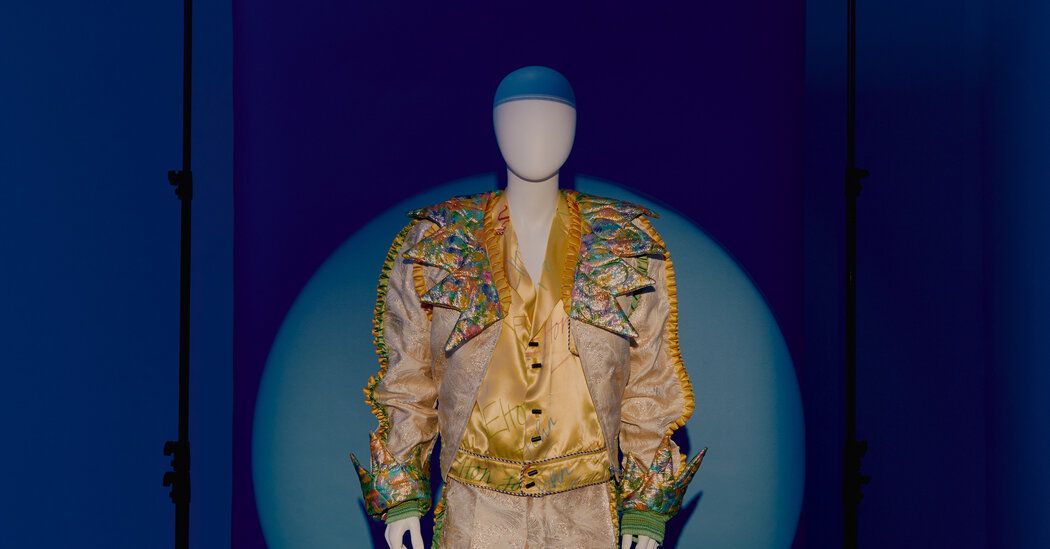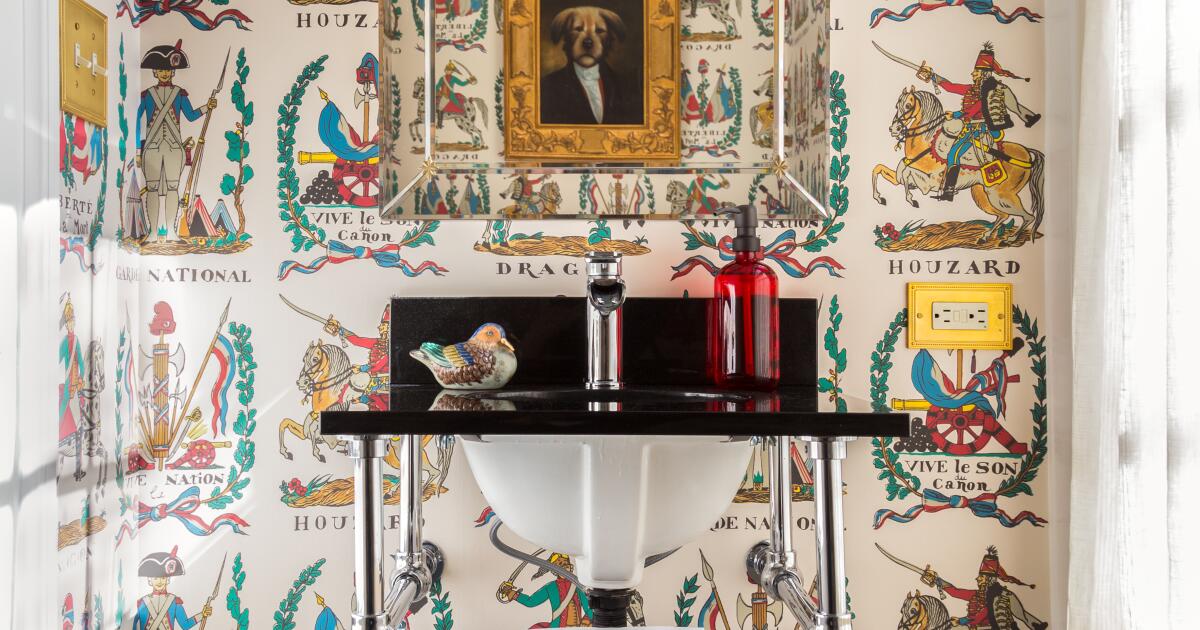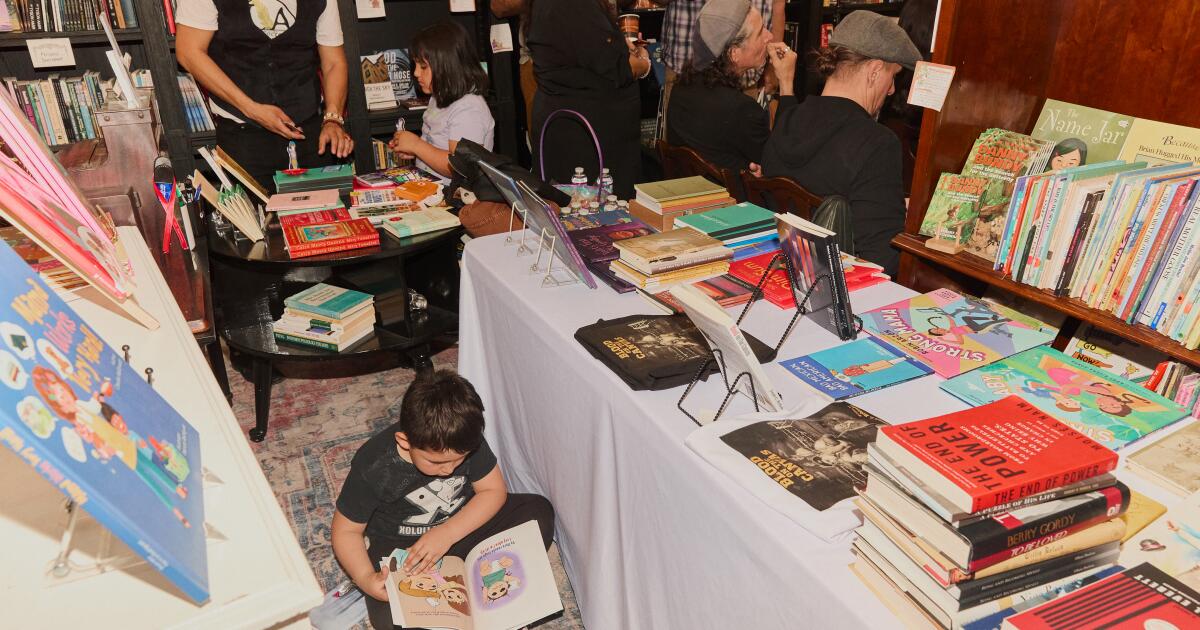Elton John is downsizing, and the superstar's former Atlanta penthouse has been emptied for a series of auctions at Christie's beginning on February 21. The items are expected to raise an estimated $10 million.
Do you want the Yamaha conservatory grand piano where Rocketman played the keys in his Broadway shows “Billy Elliot” and “Aida”? It will cost about triple what similar models sell for online, with a high estimate of $50,000.
How about Julian Schnabel's portrait of the superstar dressed in a ruffled dress and collar? The auction house is seeking $300,000.
And the most expensive item, a 2017 Banksy painting of a masked man throwing a bouquet of flowers, sourced directly from the anonymous artist, is expected to sell for nearly $1.5 million.
John declined to comment on the auction. (Christie's spokesman Agostino Guerra cited “long-planned scheduling conflicts.”) However, the singer's husband and manager, David Furnish, discussed the sale in a recent interview.
“As time went on, the walls got more crowded,” Furnish said. “Elton never kept things in drawers, he bought them to live with his art.”
But the sale of their 13,000-square-foot, 36th-floor Atlanta residence for more than $7.2 million last fall gave the couple the opportunity to solidify their collection of artwork and memorabilia. which includes the singer's famous sunglasses, his silver platform boots, and one of his first sets of stage clothing: an ivory and gold ensemble made by textile designer Annie Reavey in the 1970s.
“I met Elton John and we hit it off,” Reavey said in a 2007 interview in a Nevada newspaper. “I had purple hair, he had green hair. “I had rhinestones and he had diamonds.”
The condo on Peachtree Road symbolized a turning point for the British singer. He bought the two-story abode in the 1990s. It served as his U.S. headquarters during his tours and as a sober hideaway during the 1990s. But the walls soon became populated with dozens of photographs, part of an extensive collection of images by modern masters such as Dorothea Lange, whose images of Depression-era despair include “Migrant Mother,” and Hungarian photographer Andre Kertesz. John also collected works by Andy Warhol, Cindy Sherman, Robert Mapplethorpe and others that now have museums clamoring for donations.
Above his bed, he displayed “Noire et Blanche,” images by surrealist photographer Man Ray.
“I love living with my collection,” John said in a video promoting an exhibition of his works at the Tate Modern in 2016. “I see on the wall these wonderful images that people took a long time ago and that still have relevance and still interest you.” shout”.
When part of his collection went on display at the Tate Modern, “what was most surprising was its depth,” said Shanay Jhaveri, director of visual arts at the Barbican Center in London. “For someone whose public persona has been so indelibly associated with excess and kitsch, a collection of predominantly black-and-white, modestly scaled Western modernist photographs seemed inconsistent. Perhaps the revelation was this apparent irreconcilability.”
Atlanta was where John cultivated that love of photography, thanks in large part to a local gallerist named Jane Jackson. Her (In 2003, she became director of the Sir Elton John Photography Collection, which now includes thousands of images.) Some highlights from a 2000 exhibition, “Chorus of Light” at the High Museum of Art in Atlanta, are offered at Christie's auction, including works by Irving Penn, Richard Avedon and Andrés Serrano.
“The collection was very disciplined,” said Ned Rifkin, who curated the High Museum exhibition and developed a working relationship with the singer. “It wasn't just about acquisitions but about the beauty of having art.”
“I remember there were times when he would go to an auction and get really frustrated when he couldn't get something,” added Rifkin, now retired. “I'm disappointed to hear that he's selling, but on the other hand, he has a lot.”
The singer's husband said it was time to start pruning the collection.
“You have to get to a point where it can't continue to accumulate,” Furnish explained. “Elton hates parting with things. “It is a very emotional decision.”
To that end, Furnish has primarily handled the auction, which is the first time a major selection from John's collection has been offered to the public since Sotheby's sale of items from his London home in 2003 (which raised $1.67 million). .) In 1988, another Sotheby's auction in London featured a hodgepodge of works of art and rarities, including a Magritte painting of a blue fish wrapped in pearls, a chamber pot, and a pair of Cartier silver baskets that John once used as soap dishes, for a price of $8.2. million, or about $21 million in today's dollars.
Now, John and Furnish have decided to partner with the auction house's rivals.
“This was a competitive situation,” said Tash Perrin, a Christie's vice president who organized the sale and helped negotiate the deal. “It coincides with Elton closing a chapter of his time in America.”
Perrin said most of the 900 items up for auction will have modest prices. Many are offered for a few thousand dollars, from Lange portraits to jeweled rings and Versace dinnerware.
But as recent celebrity auctions have shown, collectors have no qualms about spending big bucks on their pop idols' trinkets. Last year's auction of rock vocalist Freddie Mercury's belongings at Sotheby's reached $50.4 million, more than tripling its initial estimate of $14.2. Bidders fought over everything from a silver mustache comb to cat ornaments and a neon telephone.
In a turbulent market, auction houses have increased promotion of these celebrity auctions, with recent sales of items owned by news anchor Barbara Walters, fashion editor André Leon Talley, French actor Gérard Depardieu and judge of Supreme Court Ruth Bader Ginsburg. each of them contributes millions of dollars.
Furnish said John's sale was designed to start thinking about the singer's legacy, as John stopped performing to spend more time with his sons, Elijah and Zachary. “That could mean more sales, gifts to institutions and gifts to friends,” Furnish said.
“One of the reasons we have been able to collect is because artists know that when they sell to us, their work will go to a home,” Furnish added. He acknowledged that in the future, “as our children grow, they may have connections with each other. “We need to elegantly find a way to incorporate them into that process.”












